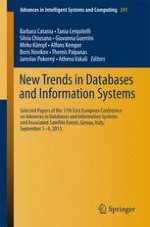This book reports on state-of-art research and applications in the field of databases and information systems. It includes both fourteen selected short contributions, presented at the East-European Conference on Advances in Databases and Information Systems (ADBIS 2013, September 1-4, Genova, Italy), and twenty-six papers from ADBIS 2013 satellite events. The short contributions from the main conference are collected in the first part of the book, which covers a wide range of topics, like data management, similarity searches, spatio-temporal and social network data, data mining, data warehousing, and data management on novel architectures, such as graphics processing units, parallel database management systems, cloud and MapReduce environments. In contrast, the contributions from the satellite events are organized in five different parts, according to their respective ADBIS satellite event: BiDaTA 2013 - Special Session on Big Data: New Trends and Applications); GID 2013 – The Second International Workshop on GPUs in Databases; OAIS 2013 – The Second International Workshop on Ontologies Meet Advanced Information Systems; SoBI 2013 – The First International Workshop on Social Business Intelligence: Integrating Social Content in Decision Making; and last but not least, the Doctoral Consortium, a forum for Ph.D. students. The book, which addresses academics and professionals alike, provides the readers with a comprehensive and timely overview of new trends in database and information systems research, and promotes new ideas and collaborations among the different research communities of the eastern European countries and the rest of the world.
